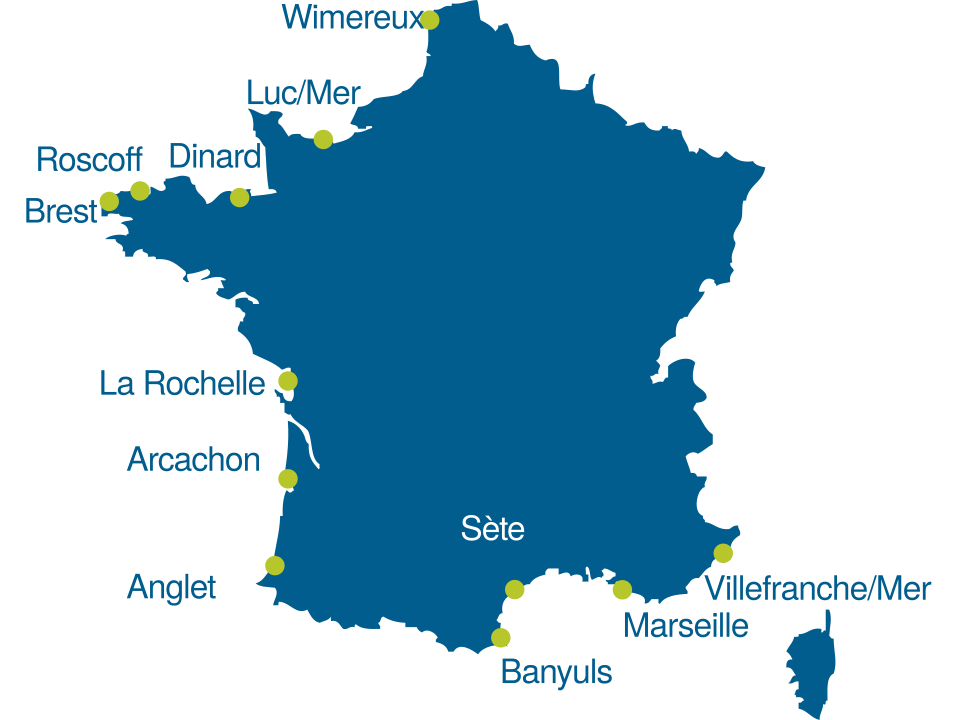Medium and long-term observations and the acquisition and study of multi-year environmental data series are essential if we wish to understand how terrestrial or marine ecosystems react both to natural environmental constraints and to human-induced stressors.
This is especially the case in coastal areas (lagoons, bays, estuaries…) which are particularly vulnerable due to the increasing pressure of human activities and are the subject conflicting uses.
The development of SOMLIT’s systematic approach for the observation of coastal environments is historically grounded in a range of local initiatives, both opportunistic and / or based on a site-specific scientific culture tied to a local Marine Research Station or Marine Laboratory. Significantly, a network of scientists working in four (4) marine research stations (located in the coastal areas of Roscoff, Arcachon-Bordeaux, Marseille and Villefranche-sur-Mer) led to establishing the Service d’Observation en Milieu Littoral (SOMLIT) in 1995. In 1996, SOMLIT was accredited by the CNRS-INSU (Ocean-Atmosphere department), giving it the status of a National Observation Service (SNO). The first accredited data series are from January 1997. SOMLIT was re-accredited in 2001, 2005, 2009, 2015 and 2020. Since 1996, eleven (11) Marine Research Stations or Marine Laboratories throughout France have officially joined and expanded SOMLIT’s scope:
- 1996: Roscoff, Arcachon-Bordeaux, Marseille and Villefranche sur Mer
- 1997: Banyuls-sur-Mer
- 1998: Wimereux and Brest
- 2007: Luc-sur-Mer
- 2011: La Rochelle
- 2012: Dinard
- 2015: Sète
- 2107: the Anglet station started acquiring SOMLIT parameters (as yet not accredited)

SOMLIT comprises eleven (11) Marine Research Stations / Marine Laboratories within its accredited perimeter and one (1) that acquires data according to SOMLIT protocols.
SOMLIT’s measurement and sampling strategy has evolved over its 20-year history. In addition to the 13 historical parameters (temperature, salinity, pH, dissolved oxygen, nitrate, nitrite, ammonium, phosphate, dissolved silica, suspended matter, chlorophyll a, carbon and particulate organic nitrogen) measured in surface waters, stable isotopes of carbon and particulate organic nitrogen as well as pico-nanoplankton have been added.
Vertical probe profiles (temperature, salinity, fluorescence, PAR) were were added in 2007.
It should be noted that most of SOMLIT sites are also monitored for:
- microphytoplankton diversity at the same frequency within the framework of SNO PHYTOBS.
- for temperature, salinity, fluorescence (and sometimes other parameters) at high frequency (automated in situ measurements every 10 to 20 minutes within the framework of SNO Coast-HF.
SOMLIT was coordinated by Jacques Castel (Professor at the University of Bordeaux) from 1995 to 1998 and by Benoît Sautour (Professor at the University of Bordeaux) from 1998 to 2017. Since June 2017, national coordination is ensured by Nicolas Savoye (Physicien Adjoint CNAP; University of Bordeaux).